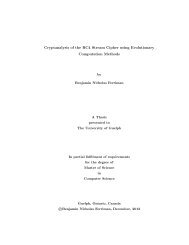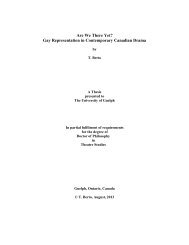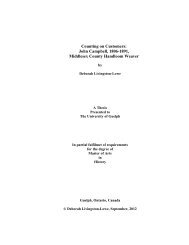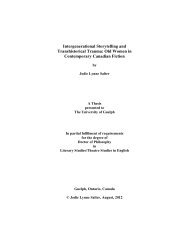THESIS - ROC CH ... - FINAL - resubmission.pdf - University of Guelph
THESIS - ROC CH ... - FINAL - resubmission.pdf - University of Guelph
THESIS - ROC CH ... - FINAL - resubmission.pdf - University of Guelph
Create successful ePaper yourself
Turn your PDF publications into a flip-book with our unique Google optimized e-Paper software.
extraction step suggested partial removal <strong>of</strong> hemicellulose and lignin. The process employed<br />
however was not optimized as WAXD results suggest a decrease in relative crystallinity <strong>of</strong> the<br />
sample through each successive step <strong>of</strong> extraction. The realization <strong>of</strong> extracting nano to micro<br />
fibers from soy waste allows for further utilization <strong>of</strong> the soy plant increasing the sustainable<br />
efforts <strong>of</strong> this project.<br />
By extruding SPI with the extracted fibers, part three <strong>of</strong> this study established the goal <strong>of</strong><br />
creating a fiber/protein composite derived from soy. Away from the optimal fiber loading <strong>of</strong><br />
0.25% w/w fiber/SPI, material performance was hampered by the presence <strong>of</strong> fiber aggregates.<br />
The presence <strong>of</strong> aggregates was thought to be induced by self-interaction <strong>of</strong> cellulose fibers<br />
further promoted by the extrusion process. Aggregate-free films exhibited potential material<br />
enhancements with tensile strength and modulus increases observed at high RH <strong>of</strong> 84%.<br />
Furthermore, FTIR analysis suggests the presence <strong>of</strong> cellulose-protein interaction at the optimal<br />
fiber concentration. WAXD analysis yielded inconclusive results which can be highly affected by<br />
sample preparation. The success <strong>of</strong> continuously extruding a fiber/protein composite film further<br />
highlights the potential for a sustainable alternative to petroleum plastics.<br />
Due to the presence <strong>of</strong> aggregates, exploratory research tried to improve the composite<br />
structure through the coupling effects <strong>of</strong> titanium dioxide addition. The experiment found that the<br />
addition <strong>of</strong> TiO2 nanoparticles can benefit both SPI base films and SPI/SMF blend films. For SPI<br />
films, tensile strength increased at an optimal concentration. The optimal concentration <strong>of</strong> the<br />
nano-filler was found to depend on the size <strong>of</strong> the particle. When TiO 2 was used as a coupling<br />
agent for SPI/SMF blend films, a positive correlation between fiber addition and tensile strength<br />
was observed. However, the synergistic effect was not significant in comparison to the optimal<br />
concentration <strong>of</strong> adding cellulose fibers alone. The synergistic effects <strong>of</strong> TiO 2 addition may be<br />
further exploited in future studies to improve SPI/fiber composite films increasing functionality<br />
and market potential.<br />
108

















